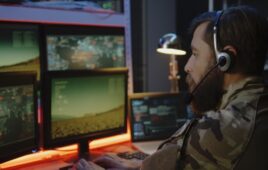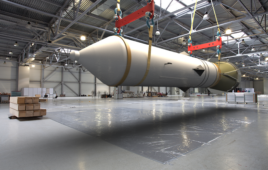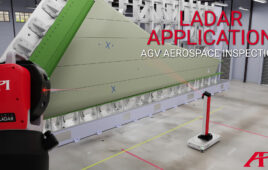Edited by Paul J. Heney, Editorial Director
Highly-evolved, aerospace technology projects continue to drive the need for engineers’ increasing ingenuity in process development and quality assurance methodology. When choosing from hundreds of coatings—each with its own set of characteristics, tolerances and limitations—designers must consider the coated component’s size, geometry, intricacy of application, material composition, working environment and life expectancy. Often, an existing coating must be modified or used in conjunction with another in order to generate the required effect.

NEOSSat solar panel substrate during initial receiving inspection.
“Over the years, many advanced companies and universities have requested unique applications beyond ‘normal’ boundaries,” said Don Garcia, Director of Research & Development for Boyd Coatings Research Co. “This has driven our engineers to develop new capabilities and to think creatively to solve these challenges.”
One particularly challenging application was introduced by Microsat Systems Canada Inc. (MSCI), prime contractor/ systems engineering in the development of the microsatellite, NEOSSat (Near-Earth Object Surveillance Satellite) for the Canadian Government. According to the Canadian Space Agency, NEOSSat is “Canada’s Sentinel in the Sky.”
The suitcase-sized NEOSSat orbits 800 km above the Earth, searching for near-Earth asteroids that are difficult to spot using ground-based telescopes. It is not limited by the day-night cycle, and operates around the clock. NEOSSat also monitors orbiting space objects to help minimize collisions between them. NEOSSat will keep track of the positions of both satellites and “space junk” as part of the High Earth Orbit Surveillance System project by Defence Research and Development Canada.
MSCI developed NEOSSat’s systems including attitude control, structure, flight and ground software and power and instruments electronics. In addition to coating some components with a more basic application of an aerospace-grade white thermal control coating, MSCI called upon Boyd Coatings to assist in the highly meticulous application of a specified laminate to some components comprising NEOSSat’s power generation systems. With regard to optics, which required a highly specialized application of black paint, NEOSSat’s payload comprised:
• a 15-cm aperture f/5.88 Maksutov telescope with a 0.86° unvignetted field of view
• two 1024×1024 frame-transfer CCDs, focal plane passively cooled to less than -40°C
• an external baffle to shield aperture from sunlight and Earth-reflected light
• a telescope able to detect and track satellites and debris in Earth’s orbit, as well as faint asteroids against the dark background of deep space.
The optics were coated by Boyd with a specialized black paint. This was a highly sensitive application, as the very dim targets (asteroids and satellites) intended for NEOSSat’s investigations require an extremely dark black on optical surfaces, so as to reject as much stray light as possible. The requirements on the optics were quite stringent—even by space telescope standards.
The laminate laydown was done on NEOSSat’s solar array components. In addition to strict adherence to precise tolerances of the lamination’s pre-defined size, shape and thickness, the extremely tight constraints of the laminate lay-down and meticulous nature of the job necessitated Boyd to develop a specialized process for the laminate’s application. Because the components would be used under a vacuum in deep space, the laminate had to be applied within a cleanroom environment to eliminate the possibility of micro-contamination or air bubbles being trapped underneath; the presence of air bubbles or contaminants would contribute to delamination in outer space. Additionally, the positioning of the lamination needed to be exact—to the thousandths of an inch—with no overlaps.
“We went to Boyd Coatings because we knew that they had the experience and expertise to handle this type of aerospace project,” said Adam Latour, MSCI’s Lead Mechanical Engineer for the NEOSSat project. “There was no defined process for this task, but we were confident that Boyd could develop one.”

NEOSSat solar panel during final inspection.
“In many cases, it is the specification or development of a high-performance coating that is the special part of Boyd Coatings’ offering,” said Garcia. “In this case, it was the ability to develop a documented process to lay down the coating in a particularly precise and meticulous manner, ensuring that no micro-contamination or air was trapped underneath.”
“We’ve been seeing a trend in the application of high-tech coatings for some time now,” explained Garcia. “As engineers design smaller or more specialized devices with increasingly complex geometries, coaters must be innovative in their coatings design and application methodology.”
Frustratingly, processes that have been painstakingly designed, tested and proven oftentimes require redesign.
“Advances in coatings materials have also necessitated enhancements/modifications on our part in order to comply with environmental concerns,” said Garcia. “Initiatives such as RoHS, REACH, and the others have made it necessary for us to research and change some of the methodologies we use to manufacture and apply coatings materials. “These modifications affect the entire process and, not surprisingly, changes to the process can sometimes have unforeseen consequences. As this directly affects product performance and efficacy, we take this very seriously and therefore perform all the necessary due diligence to ensure there are no negative impacts. It’s a lot more complicated than it appears.”

The completed NEOSSat underwent Integrated Satellite Testing at The David Florida Laboratory. The David Florida Laboratory is Canada’s world class spacecraft assembly, integration and testing center located in Ottawa, Canada.
On February 25, 2013, NEOSSat was successfully launched into outer space where it now guards Earth, as it was designed to do.
Boyd Coatings Research Co.
www.boydcoatings.com
Filed Under: Aerospace + defense, Materials • advanced





Tell Us What You Think!